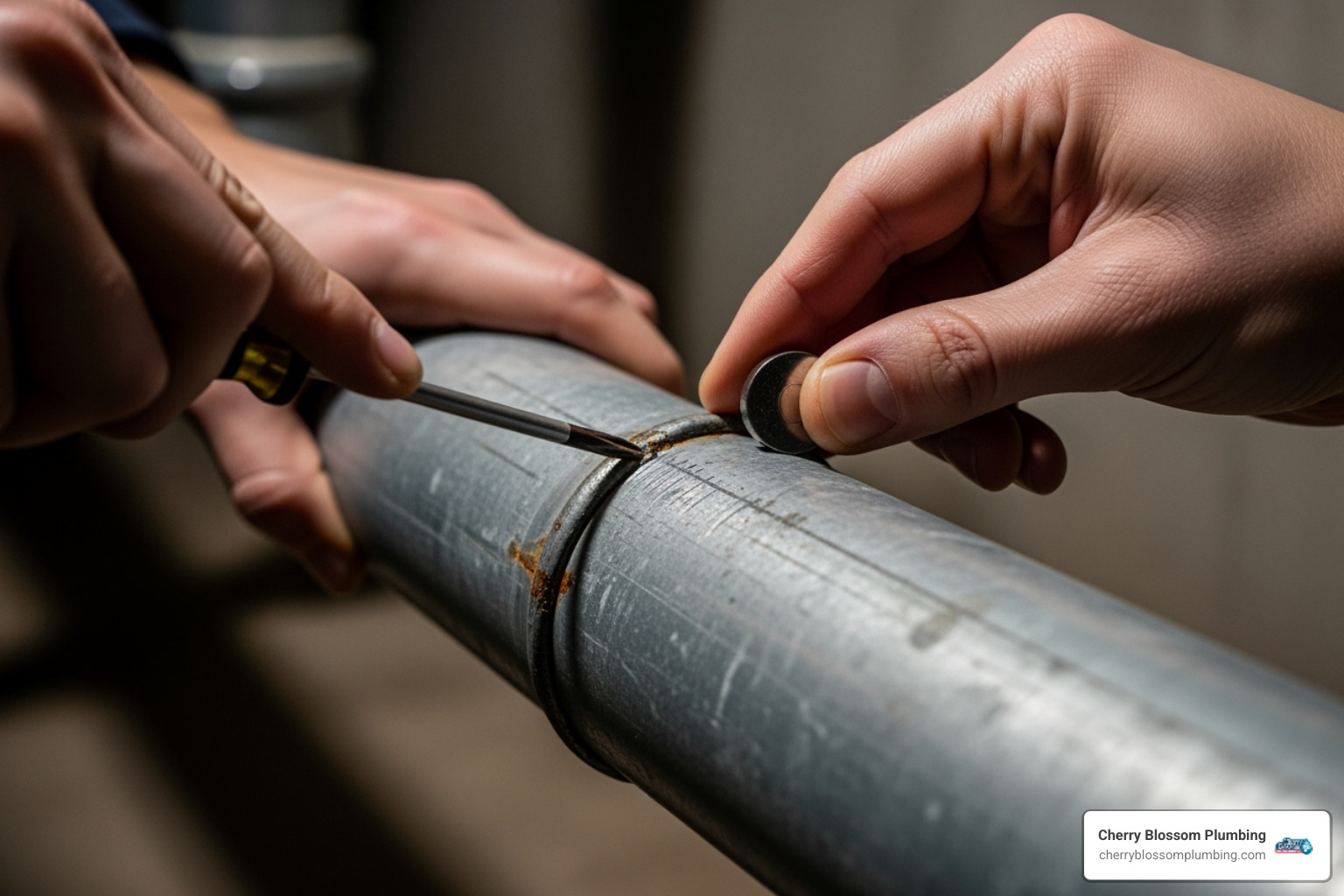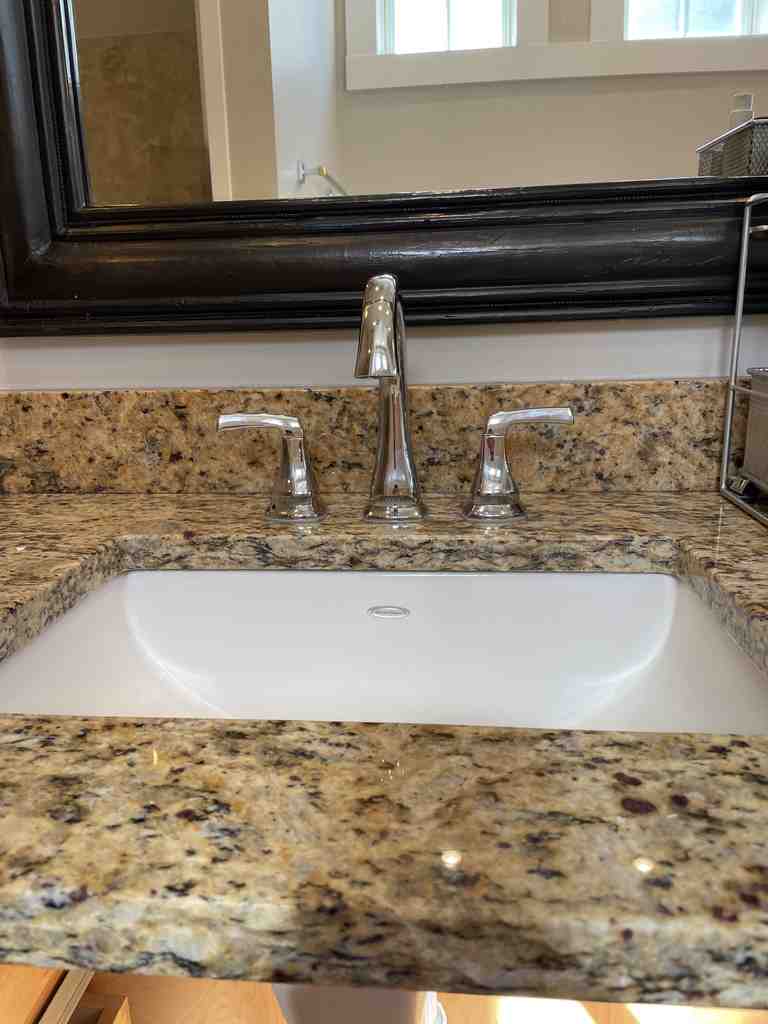
Why Galvanized Plumbing Could Be a Hidden Problem in Your Home
Galvanized plumbing refers to steel pipes coated with zinc to prevent rust and corrosion. Common in homes built from the 1920s through the 1960s, these pipes are now well past their intended lifespan and pose significant risks to water quality and home safety.
Quick Facts About Galvanized Plumbing:
- Lifespan: 40-60 years (most are now past their prime)
- Main Problems: Internal corrosion, rust buildup, low water pressure, potential lead contamination
- Health Risks: Lead exposure from zinc coating impurities, especially in pipes installed before 1960
- Identification: Silver-gray color when scratched, magnetic, threaded connections
- Solution: Complete replacement with modern materials like copper, PEX, or CPVC
If you live in an older home in the Arlington or Falls Church area, your plumbing system likely includes galvanized pipes. What was once a safer alternative to lead pipes is now a major concern for homeowners dealing with rusty water, declining water pressure, and potential health hazards.
The protective zinc coating wears away over time, exposing the steel to rust and corrosion. This buildup can shrink a pipe's interior diameter to the size of a pencil, and worse, the zinc coating itself often contained lead that can leach into your drinking water.
I'm Amanda Casteel of Cherry Blossom Plumbing. I've seen how aging galvanized plumbing creates ongoing problems for families in Northern Virginia. My experience helps me guide homeowners through the complex decision of when and how to address their aging plumbing infrastructure to prevent water quality issues and costly emergency repairs.

What Is Galvanized Plumbing and Why Was It Used?
From the 1920s through the 1960s, galvanized plumbing was the material that promised safety and durability. As the dangers of lead pipes became clear, these zinc-coated steel pipes were seen as the perfect solution, offering a reliable and affordable alternative for home construction across America.
Galvanized plumbing consists of steel or iron pipes coated with a protective layer of zinc through a process called hot-dip galvanization. This was considered a breakthrough that would keep families safe from lead poisoning while providing decades of reliable water service. For nearly half a century, it was the gold standard for residential plumbing.
How Galvanized Pipes Are Made
The creation of galvanized pipes involves giving steel a protective zinc "jacket." First, steel pipes are thoroughly cleaned to remove all impurities. Then, the pipes are plunged into a molten zinc bath heated to about 840°F. At this temperature, the steel and zinc bond at a molecular level, creating a durable, multi-layered coating.
This protective barrier becomes part of the pipe itself. The zinc acts as a sacrificial coating, meaning it will corrode first to protect the steel underneath from rust. After cooling, the pipes have a distinctive silver-gray finish and are installed using threaded connections.
Historical Advantages
In its time, galvanized plumbing offered compelling benefits that made it the standard choice for decades.
The most critical advantage was improved safety over lead. It provided families with drinking water free from the threat of lead poisoning, a genuine life-saver.
Perceived durability was another major selling point. The combination of strong steel and a protective zinc coating promised a plumbing system that would last for generations with minimal maintenance.
Lower cost than copper made galvanized pipes accessible to the average family, especially in post-war America. While copper was available, its premium price was a barrier for many.
Finally, widespread availability and familiarity among plumbers meant installations were fast and standardized, which builders relied on nationwide. It seemed like the perfect combination of safety, durability, and affordability.
The Downside: Common Problems with Galvanized Plumbing
What once seemed like a brilliant solution has become a modern homeowner's headache. The fundamental flaw of galvanized plumbing is how it ages. The protective zinc coating gradually wears away, allowing water and oxygen to attack the exposed steel, leading to internal rust and corrosion.

Most galvanized plumbing systems last 40 to 60 years. Since most were installed before the 1970s, they are now well past their expiration date. As the steel rusts from the inside out, mineral deposits stick to the rough surfaces, shrinking the pipe's interior. A pipe that was once half an inch wide may now have an opening no bigger than a pencil. This relentless process of deterioration is called corrosion.
Signs Your Pipes Are Failing
Your home will usually give you warning signs before a complete failure. Knowing what to look for can help you act before a small problem becomes a disaster.
- Low water pressure: This is often the first sign, as rust and mineral deposits clog pipes and restrict flow. You may notice weak showers or faucets that take a long time to fill a pot.
- Discolored water: When steel rusts, iron particles can turn your water brown, yellow, or red. This is most noticeable when you first turn on a faucet that hasn't been used for a while.
- Rust stains: Persistent rust stains in sinks, tubs, and toilets are evidence that iron is leaching from your pipes.
- Frequent leaks: Corrosion weakens pipe walls, leading to pinhole leaks that often start at the threaded joints. These can cause significant water damage before they are finded.
- Pipe bursts: In severe cases, corroded pipes can burst, flooding your home and causing thousands of dollars in damage.
- Uneven water distribution: You might have good pressure in one part of the house but a trickle in another, indicating corrosion is affecting pipes at different rates.
Lifespan and Water Quality
The lifespan of galvanized plumbing depends heavily on local water conditions. Hard water, which is common in Northern Virginia, accelerates deterioration. The minerals in hard water stick to corroded surfaces, building up scale and narrowing the pipe even faster.
As pipes age, they also affect water taste and quality. The iron released from corrosion gives water an unpleasant metallic taste. The rough interior surfaces can also harbor bacteria, which may cause foul odors and further degrade water quality. If your home was built before 1970 and has original galvanized plumbing, it's almost certainly experiencing some level of internal deterioration.
Health Risks and How to Identify Galvanized Pipes
The problems with aging galvanized plumbing extend beyond low water pressure. These deteriorating pipes can quietly compromise your family's health by contaminating your water supply.

As the zinc coating breaks down, it can release harmful substances. The corroded interior also creates a perfect breeding ground for bacteria and can trap contaminants, which may be released later in dangerous concentrations.
Key Health Risks of Galvanized Plumbing
Lead exposure is the most serious threat. While marketed as a lead-free alternative, the zinc coating itself often contained lead impurities, especially in pipes installed before 1960. As the zinc wears away, this lead leaches into your water.
Furthermore, galvanized pipes can act like sponges, absorbing lead particles from old lead service lines. As the pipes deteriorate, this stored lead can be released suddenly, creating a significant health hazard. Children are most at risk, as even low levels of lead can cause permanent developmental and cognitive damage. In adults, lead exposure can lead to fatigue, headaches, kidney damage, and cardiovascular problems.
Beyond lead, the deteriorating coating can release other heavy metals like cadmium. The rough, pitted interior surfaces also become a haven for harmful bacteria, posing risks to those with compromised immune systems.
How to Identify Galvanized Pipes in Your Home
Figuring out if you have galvanized plumbing is possible with a few simple tests. Start by looking at exposed pipes in your basement, crawl space, or near your water heater.
- Appearance: Galvanized pipes are a dull, metallic gray. Over time, they may darken or develop a rusty, brownish color as the zinc wears off. They are typically thick and rigid.
- The Scratch Test: This is the most reliable method. Use a screwdriver to scratch the pipe's surface. If it reveals a silvery-gray metal, it's likely galvanized steel. Copper will be penny-colored, and plastic is easily identifiable.
- The Magnet Test: Steel is magnetic. If a strong magnet sticks firmly to your pipe, you have steel pipes, which includes galvanized plumbing. Magnets will not stick to copper or plastic.
- Connections: Galvanized pipes use bulky, threaded fittings that are screwed together, unlike the soldered joints of copper or clamped connections of PEX.
- Home's Age: If your house was built before 1960 and has not had major plumbing renovations, there is a very high chance it has galvanized pipes.
If you're unsure, our team at Cherry Blossom Plumbing can perform a thorough inspection and arrange for water quality testing to give you definitive answers.
The Modern Solution: Replacing Galvanized Pipes
Once you've identified galvanized plumbing and its telltale signs of aging, the most effective long-term solution is a complete replacement, or repiping. While it sounds like a major project, it's one of the smartest investments you can make in your home's safety and value.

Whole-home replacement eliminates the health risks, water quality issues, and frustrating plumbing emergencies associated with old galvanized pipes. Instead of patching recurring leaks, you get a fresh start with modern materials designed to last for decades. Repiping also significantly boosts your property value and provides peace of mind.
Modern Alternatives to Galvanized Plumbing
Today's plumbing materials are far superior to old galvanized steel. You have three excellent options, each with distinct advantages.
| Material | Durability | Flexibility | Corrosion Resistance | Typical Applications |
|---|---|---|---|---|
| Copper | Excellent (50-75+ years) | Low (rigid pipes) | Excellent | Hot/cold water supply, main lines, radiant heating |
| PEX | Very Good (50+ years) | Excellent (flexible tubing) | Excellent | Hot/cold water supply, radiant heating, often preferred for whole-home repiping |
| CPVC | Good (50+ years) | Moderate (more rigid than PEX, less than copper) | Very Good | Hot/cold water supply, fire sprinkler systems |
Copper remains a gold standard, offering exceptional durability (50-75+ years) and natural corrosion resistance. It doesn't leach harmful chemicals, providing long-term reliability.
PEX (Cross-Linked Polyethylene) is a flexible plastic tubing that has revolutionized repiping. It bends around corners, requiring fewer connections and reducing potential leak points. Its resistance to corrosion, scale, and freezing makes installation faster and less invasive.
CPVC (Chlorinated Polyvinyl Chloride) is a budget-friendly rigid plastic pipe that handles hot and cold water well. It offers good corrosion resistance and is easier to install than copper.
At Cherry Blossom Plumbing, we help Arlington and Falls Church homeowners choose the best material based on their home's layout and needs.
The Replacement Process
Replacing your galvanized plumbing is a systematic process designed to minimize disruption.
- Professional Inspection: We evaluate your current system, map out the galvanized pipes, and discuss your needs to recommend the best material and create a custom plan.
- Home Protection: Before work begins, we lay down protective sheeting and set up dust barriers to keep your home clean.
- Removal and Installation: Our skilled plumbers carefully remove old galvanized sections and install the new pipes, using techniques to minimize damage to walls and ceilings.
- System Testing: Finally, we test every connection for leaks and verify proper water pressure throughout your home to ensure the new system works perfectly.
Most repiping projects take just a few days, leaving you with a reliable, modern plumbing system.
Frequently Asked Questions about Galvanized Pipes
When homeowners in Arlington and Falls Church find they have galvanized plumbing, they have many questions. Here are answers to the most common concerns.
Do all galvanized pipes need to be replaced immediately?
Not necessarily this minute, but replacement should be planned for the near future. If your home was built before 1970, your original galvanized plumbing is living on borrowed time.
Replacement becomes urgent if you see visible signs of trouble, such as external rust, frequent leaks, or discolored water. Widespread low water pressure is another clear signal that pipes are severely clogged. Finally, if water quality tests show liftd levels of lead, replacement is a health priority, especially with children in the home.
Choosing to replace your pipes proactively allows you to plan the work and avoid the stress and expense of an emergency burst pipe and the resulting water damage.
Can I replace only a small section of galvanized pipe?
While tempting, a partial replacement of galvanized plumbing is usually a bad idea. The main issue is galvanic corrosion: connecting new copper pipe directly to old galvanized steel creates an electrochemical reaction that causes the old pipe to corrode even faster at the connection point.
Fixing one leak doesn't solve the underlying problem. If one section has failed, the rest of the pipes are likely in similar condition, meaning another leak is just around the corner. Disturbing old pipes can also dislodge trapped lead particles, temporarily increasing lead levels in your water.
For these reasons, whole-home repiping is almost always the smarter investment, providing a completely reliable system rather than a temporary patch.
Does homeowners insurance cover damage from galvanized pipes?
This has become a tricky issue. Many insurance companies now view aging galvanized plumbing as a pre-existing problem and may not cover damage it causes.
Most policies include exclusions for damage from gradual deterioration, slow leaks, or lack of maintenance. While a sudden pipe burst might be covered, damage from a slow, ongoing leak likely won't be. If an adjuster determines the failure was due to neglected, old pipes, your claim will probably be denied.
Some insurers are even requiring homeowners to replace galvanized plumbing to obtain or renew a policy. The trend is clear: insurance companies see these old pipes as a major liability. Upgrading your system is not just about water quality; it's about protecting your financial investment in your home.
Conclusion
If your Arlington or Falls Church home was built before 1970, you are likely living with galvanized plumbing that is silently failing. What was once a modern material has become a source of internal corrosion, contaminated drinking water, potential lead exposure, and ever-weakening water pressure. These are serious issues that affect your family's health and your home's value.
The good news is that you don't have to live with rusty water and weak showers. Modern materials like copper, PEX, and CPVC offer safe, reliable alternatives that will last for decades.
At Cherry Blossom Plumbing, a family-owned business serving Arlington and Falls Church, we've seen the transformative effect of replacing galvanized plumbing. Our customers enjoy strong, clean water pressure and gain peace of mind about their family's safety. Our inspection process is straightforward, and our "WOW factor" guarantee ensures exceptional service.
Don't wait for an emergency repair or wonder about your water quality. Take control of your home's plumbing future.

Schedule your professional plumbing inspection with Cherry Blossom Plumbing today. Your family's health and your home's safety are worth it.
Customer Testimonials
Cherry Blossom Plumbing has consistently provided top-notch service, ensuring every issue is resolved efficiently and professionally.







